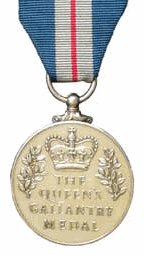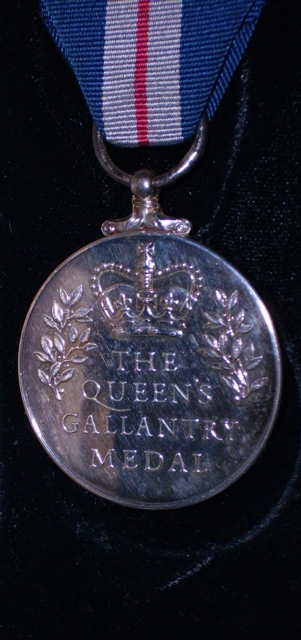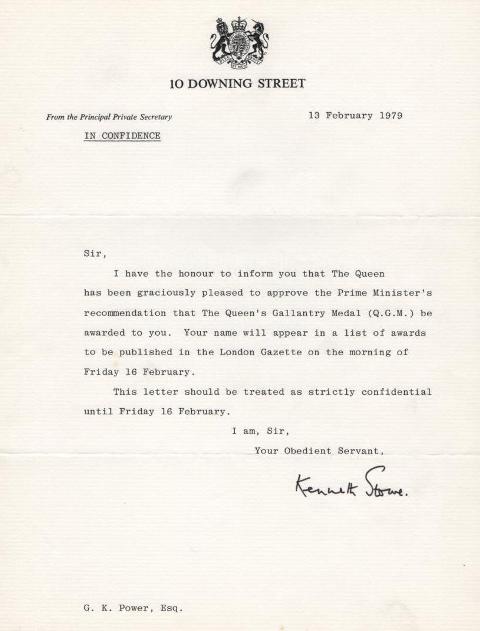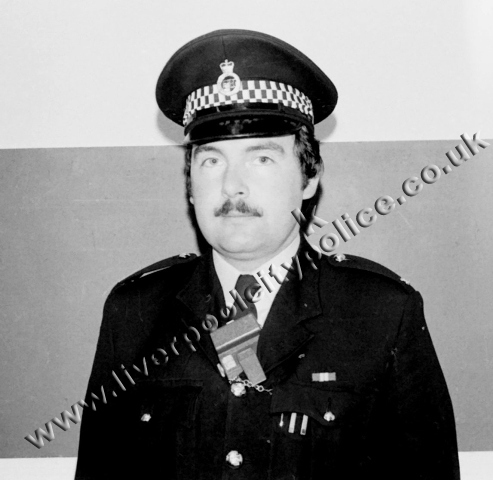Queen’s Gallantry Medal (QGM)
by peter delius retd.
From the 30th of November 1977 it has also been awarded posthumously and so from that date it has replaced the Queens Police Medal which could only be awarded for gallantry posthumously.
The Queen’s Gallantry Medal is only awarded very sparingly and to date only 600 have been awarded.
The Merseyside Police is represented amongst recipients of the Queens Gallantry Medal with six awards to its officers, although at least one other officer has the Medal but won it whilst serving with another Police Force.
The Merseyside Officers are : –
(Rank given as at time of award)
Inspector John Frederick Lea
Sergeant Thomas William Davies
Constable 3084 “G” George Kenneth Power
Fire Rescue
Sergeant Denis Henaghan
Fire Rescue
Constable Derek Peter Murphy
Constable Kenton Robert Owen
Firearms Incident
The Queen’s Gallantry Medal, awarded for Exemplary Acts of Gallantry to Civilians (Members of Armed Forces can be eligible if not in face of the enemy) Instituted on the 20th of June 1974 to replace the Order of the British Empire (Gallantry),British Empire Medal (gallantry) and Colonial Police Medal (Gallantry). It ended the rather strange situation whereby the OBE was awarded for lesser acts of gallantry than the George Medal but took precedence over it.
Inspector John Frederick LEA
Sergeant Thomas William DAVIES
Following a shooting incident on 9th July, 1975, when three policemen were fired upon, enquiries revealed that the three gunmen responsible were terrorists.
The following day, as a result of information received, the whereabouts of the gunmen became known. A squad of police officers, thirteen of whom were armed, were sent to the scene. Inspector Lea, Sergeant Davies and another officer were members of the armed support group which followed the senior officers who made the initial entry into the three-storey house. They positioned themselves on the landing outside the door of a top floor flat at the front of the house. It was then discovered that the terrorists were not, as expected, in the top floor flat and, at the same time, Inspector Lea and Sergeant Davies heard men’s voices coming from the first floor flat. They shouted that they were Police officers and Sergeant Davies kicked at the door while Inspector Lea put his shoulder to it. Almost immediately a shot was fired from inside the room and Sergeant Davies was wounded in the abdomen, but before he fell to the ground he managed to fire a single round. Regardless of the danger, Inspector Lea managed to pull Sergeant Davies out of the line of fire.
Inspector Lea then shouted to the men to lay down their arms and surrender, only to be told that they had 500lbs.of explosive in the flat and if the police tried to enter they would blow up the house. Inspector Lea remained where he was and continued repeatedly to call to the occupants of the flat to come out with their hands up although he could hear the sound of automatic weapons being loaded. After some time the men called that they were coming out; the door opened and the three terrorists appeared with their hands above their heads. Inspector Lea told them to keep their hands up and walk out of the house; they were then arrested. A subsequent search of the premises occupied by the terrorists revealed a number of arms including a light machine gun, a sten sub-machine gun, hand guns, ammunition, timing devices, detonators, and electrical equipment capable of causing an explosion and 500 lbs. of explosive.
Inspector Lea and Sergeant Davies displayed outstanding gallantry, devotion to duty and a complete disregard for their own safety when they fearlessly exposed themselves to great danger to bring about the eventual arrest of these three dangerous criminals.
Sergeant 2663 Denis HENAGHAN
During the early hours of the 28th November 1977, a fire developed in a dwelling house where two small children were asleep in a first floor front bedroom. The fire Brigade was summoned but only emergency fire-fighting facilities were available (*) and two Army pumping appliances, escorted by two police cars, were despatched. The living room, hall and staircase were a blazing inferno when the services arrived at the scene.
Sergeant Henaghan attended and with a member of the Army team, was joined by another fireman and climbed a ladder to the first floor bedroom window with the intention of rescuing the children and their grandfather, who had earlier made a rescue attempt and was believed to still be in the house. At this stage conditions were extremely hazardous; the door leading to the upstairs landing was jammed as the bedroom ceiling had collapsed.
The Sergeant used an axe to break down the door and was confronted with the fiercely burning landing and upper staircase. With Sergeant Henaghan using a hose to reduce the blaze, they managed to work their way to the head of the stairs where they found a man’s body. The landing then collapsed and Sergeant Henaghan fell to the hallway below; fortunately he was uninjured and returned again to the upper floor via the ladder. At this point, however, all personnel were ordered to withdraw because of the dangerous state of the building.
Sergeant Henaghan displayed bravery and devotion to duty of a high order when without regard for his personal safety, he entered the building three times despite the fact that it was burning fiercely and the internal structure was collapsing.
(*) Industrial Action was being taken and the Fire Brigade was on Strike.
Constable 3084 George Kenneth Power
George Kenneth POWER was born on the 1st of June 1950 and joined the Warwickshire Constabulary in September 1966, transferring to the Liverpool and Bootle Constabulary Cadets in 1968. He was appointed to the regular force in July 1969 and after training at Bruche DTC was posted to “G” Division , with the number 168 G” and served at Eaton Road Police Station.
Upon the creation of Merseyside Police in April 1974 George was re-numbered 3084 but remained at Eaton Road.
During the late evening of the 24th November 1977, a fire believed to have been started by a small boy, broke out in the upper floor of a dwelling house, 9 Fincham Crescent, Huyton with the result that he and a six month old baby were trapped in separate bedrooms. A neighbour alerted by the children’s mother, succeeded in getting into the boys bedroom, but was beaten back by the intense heat; she tried twice more to get inside the bedroom with the screaming child only to be beaten back. Other unsuccessful attempts to rescue the children unfortunately, although well intentioned, had resulted in broken windows which had increased the intensity of the fire.
End of Official Citation
The Police were alerted and any officers making to the scene would be well aware that any assistance would be slow in arriving as the Fire Brigade was on strike and reliance was upon the British Army, who were not familiar with the area, and Green Goddess Fire Appliances.
Resumption of Official Citation:
By the time Constable Power and another officer arrived at the scene the fire had increased; the floorboards and carpet in the room were burning and thick black smoke billowed out. The fire had spread to the ceiling above the landing, the wooden loft entrance was well alight and they could hear a child screaming. Constable Power, closely followed by his colleague, ran into the house and up the stairs. The officer with Constable Power entered the front bedroom to search for a child but was driven out by the heat and smoke.
Constable Power then entered the room and after feeling his way, found the baby which he handed to the other officer who took it to safety and then returned to the landing to help her colleague.
Regardless of the now appalling condition in the back bedroom Constable Power entered the room. The fire had been fanned to greater intensity by draught from the broken windows and the heat was fierce. The officer fought his way through the smoke and flames to rescue the now badly burnt child from the bunk bed in the furthest corner of the room. Both Officers then left the house with the boy.
Constable Power displayed outstanding courage, determination and a total disregard for his own safety when, in spite of worsening conditions, he rescued both children and succeeded where the rescue attempts of others had failed.
The Officer in company with Constable Power was Sheila Ann Jones and she received a Queens Commendation for Brave Conduct (Oak leaf worn on tunic)
Both officers were awarded the Force Merit Badge by the Police Authority.
Constable Derek Peter MURPHY
Constable Kenton Robert OWEN
At 12.20 a.m. on Thursday, 21st January 1988, Constable Murphy and Owen were on mobile patrol in a police vehicle. They saw a van parked in a public car park with its headlights on, the engine running and the windscreen wipers operating, despite the weather being dry. The officers decided to investigate.
Constable Owen drove the police vehicle to within a few feet of the van stopping in front of it to prevent the van being driven off by the occupant. Both constables alighted from the police vehicle and approached the van to find a man in the driver’s seat who appeared to be asleep. Constable Murphy roused the man and began to question him. As the man failed to give a satisfactory account of himself, Constable Owen decided to check the van’s registration number through the Police National Computer. Information received revealed a discrepancy between the registration number and the type of vehicle. When questioned further, the occupant reached into a holdall which was on the front passenger seat. Constable Owen saw him withdraw a sawn-off shotgun. The officer immediately shouted a warning to Constable Murphy. As the man alighted from the van he pointed the gun first at Constable Murphy’s stomach, and secondly at Constable Owens head, in both cases at close range. Constable Murphy realizing that his colleague was in immediate danger grappled with the gunman. A violent struggle took place during which the gun was discharged twice by the gunman, on the first occasion at Constable Owen’s head and then at Constable Murphy’s stomach, missing both officers. The gunman broke free and ran towards his van. He appeared to be reloading the gun. Constable Owen ran to the police vehicle and drove it towards the gunman, trapping him in the doorway of the van. When the police car reversed, the gunman attempted to run off, holding the gun. Constable Owen made a further attempt to stop the gunman by driving into him, knocking him to the ground. As the gunman attempted to run off again, Constable Murphy tackled the man, unaware that the gun was now lying on the ground. He was joined by Constable Owen. The man, who was in fact a wanted criminal, was eventually overcome, subdued and taken into police custody. The man was subsequently charged and convicted of a number of serious crimes.
Constables Murphy and Owen displayed gallantry of a high order, in overpowering an armed, violent and highly dangerous man, after he had discharged his weapon at them twice at close range.
The gunman was Andrew Longmire, at the time the most wanted man in Britain. He is serving life sentences for Rape of Women and young girls, Aggravated Burglary and firearms offences. He had previously escaped from two Police Officers after pulling the shotgun on them at a railway Station.






